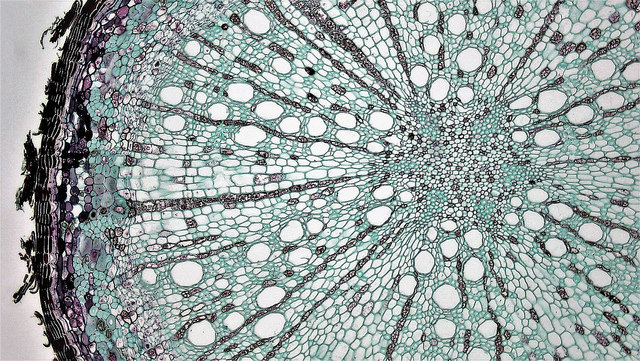 Plant Biology
Plant Biology
One root for every soil: a double-personality tale

In biology, life success is based on the ability to have offspring. For that, before reproduction, organisms must deal with different and sometimes unfriendly situations. The capacity to overcome environmental challenges increases the possibility to have descendants, and will determine then that organism's life success.
A widespread strategy to deal with uncomfortable situations is to move. For example, some birds have exploited this ability by flying to warmer places during winter. However, plants are fixed to the soil, and their survival will depend on the ability to react quickly to environmental changes without being able to escape.
One way to understand the tight connection between plants and their environment is to study the organs that anchor them. Roots have two very different roles. On one hand, they restrict the movement of the plants. But on the other, they are very plastic, and can modify their architecture and composition in response to external cues.
The main component of roots are its vessels: thin tubes within them that transport the minerals and water that all plants need for growing. These vessels are surrounded by a tissue called endodermis, which protects them from the environment. Apart from its protective function, the endodermis is also responsible for absorbing nutrients. Under tough conditions, such as drought or high levels of salt, the endodermis can focus more into its protective role by changing its composition. However, when focusing on protecting the vessels, the endodermis is less effective in its role of absorbing nutrients.
Scientists from the University of Lausanne observed how deficiencies of several important minerals affect the composition of a root's endodermis. For that, they used the plant model Arabidopsis thaliana, frequently used in research since it is easy to grow, it produces seeds in a relatively short time, and a huge collection of mutants is available for scientific purposes. In this study, mutant plants with an abnormal root composition and mutants that are not able to assimilate some minerals were grown under different soil conditions. The way that the different mutants reacted to the different soils gave information on how certain mineral deficiencies affect the composition of the root. The results showed that the lack of potassium and sulfur changes the endodermis to become more protective and less absorbent. Contrarily, the lack of iron and manganese makes roots more prone to absorb, but less protective. The two opposite responses are mediated by two different plant hormones, abscisic acid and ethylene, involved in many other processes of the plant. Their results also showed that these responses can be reversed, and they can be triggered every time an environmental change occurs.
In conclusion, not only drought or salt, but also certain nutrients, can trigger changes in root composition. This finding helps us to understand the trade-off between protecting the inner root and absorbing nutrients from the soil. Plants can therefore protect their roots in response to unfavorable conditions, but they can also lose this protection to become more absorbent if, as a consequence, some nutrient becomes limited. These results show us how, despite not being able to move, plants can still cope with the lack of minerals and water in the soil.
In the same way that, to know Dr. Jekyll, it is necessary to know Mr. Hyde, plant roots are organs with two opposite functions that are tightly connected. Integrating both functions is the key to understanding how plants are able to grow under different soil conditions. As Dr. Jekyll said, "of the two natures that contended in the field of my consciousness, even if I could rightly be said to be either, it was only because I was radically both." (Strange Case of Dr. Jekyll and Mr. Hyde, Robert Louis Stevenson).
Original Article:
Barberon M, Vermeer J, De Bellis D, Wang P, Naseer S, Andersen T, Humbel B, Nawrath C, Takano J, Salt D, Geldner N. Adaptation of Root Function by Nutrient-Induced Plasticity of Endodermal Differentiation. Cell. 2016;164(3):447-459. doi:10.1016/j.cell.2015.12.021.Next read: Nitrogen pollution from lowlands reaches distant mountain lakes by Beth Hundey , Katrina Moser , Fred Longstaffe
Edited by:
Dr. Carlos Javier Rivera-Rivera , Managing Editor
We thought you might like
Why some forests burn better than others
May 19, 2015 in Earth & Space | 4 min read by Elisa Dell'AglioTara Oceans Expedition sequences the ocean
Nov 24, 2015 in Earth & Space | 4 min read by Chris BowlerOcean acidification and its effects on coral reef growth
Jul 8, 2016 in Earth & Space | 3.5 min read by Rebecca AlbrightResetting nature’s clock: shifting seasons and species relationships
Sep 14, 2016 in Earth & Space | 3.5 min read by Stephen Thackeray , Sarah BurtheMore from Plant Biology
Unravelling the Secrets of Pine Roots: A Tale of Nutrition and Adaptation
Oct 20, 2023 in Plant Biology | 3.5 min read by Rafael Cañas , Francisco OrtigosaStressful memories help plants resist caterpillars
Oct 2, 2023 in Plant Biology | 3.5 min read by Samuel Wilkinson , Adam Hannan Parker , Jurriaan TonDecoding the genome of a jackfruit that grows all year round
Sep 6, 2023 in Plant Biology | 3.5 min read by Tofazzal IslamLife after logging: the tale of recovering tropical forests
Aug 21, 2023 in Plant Biology | 3.5 min read by Maria Mills , Terhi RiuttaEditor's picks
Trending now
Popular topics


